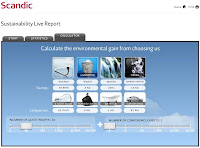As business travelers often do, I sit at the end of the day to catch up on email and other daily chores and start to acknowledge there is something different about this hotel stay at one of the Scandic hotels in Malmo, Sweden. Yes, linens are only replaced when necessary and lighting it controlled by your key card. Rehydrating after a long day, I sip tap water, yes tap water, out of a glass that is actually made from glass. I work on a small desk and wooden task chair (locally sourced), lit by a single, small compact fluorescent task light. Next to the desk on the oak flooring (recycle material) sits a waste management system, a wastebasket compartmentalized for organics, recyclables and other materials. The hotel’s brochure on sustainability lies nearby and I read the hotel chain is a Nordic Swan Award (sustainability) winner. It has developed its own water treatment capability that leaves important salts and minerals in the water and has eliminated the sale of 1.6 million liters of bottled water (3.5 million bottles) per year, in additional to 160 tons of carbon dioxide emission in transportation of that water to its hotels. Waste water streams are managed and treated separately. I even went on line to calculate the environmental impact of my stay. Seems they’ve taken this sustainability thing pretty far.
Lessons learned from all this: 1) living a more sustainable lifestyle will be easier than we think and won’t require any noticeable sacrifices. 2) consumer behavior can change, if change is made easy. (it was easy to put the right trash into the right receptacle), and, 3) this experience supports my belief that there are two big leverage points for sustainable development: Multinational Corporations (MNCs) and urban development. I wasn't planning for this to occur, but it has been one of the most insightful discoveries on my visit here.
In 2008, for the first time in human history, more people lived in urban environments than rural settings. This trend is projected to grow in coming years to almost 2/3rds . Copenhagen and Malmo are not Upopia in the Thomas Moore sense, but are rather living examples of what this future might look like.







No comments:
Post a Comment